Pelicans are a genus of large water birds comprising the family Pelecanidae. They are characterised by a long beak and large throat pouch used in catching prey and draining water from the scooped up contents before swallowing. They have predominantly pale plumage. The bills, pouches and bare facial skin of all species become brightly coloured before the breeding season. The eight living pelican species have a patchy global distribution, ranging latitudinally from the tropics to the temperate zone, though they are absent from interior South America as well as from polar regions and the open ocean.
Long thought to be related to frigatebirds, cormorants, tropicbirds, gannets and boobies, pelicans are now known instead to be most closely related to the Shoebill and Hamerkop, and are placed in the order Pelecaniformes. Ibises, spoonbills and herons are more distant relatives, and have been classified in the same order. Pelicans frequent inland and coastal waters where they feed principally on fish, catching them at or near the water surface. Gregarious birds, they often hunt cooperatively and breed colonially. Four white-plumaged species tend to nest on the ground, and four brown or grey-plumaged species nest mainly in trees.
All pelicans share some distinct characteristics, including:
Long, broad wings suitable for extensive soaring flight
Huge bill with an extendable pouch below the lower mandible
Piscivorous diets, though they also eat other aquatic prey
Heavy body proportions and short legs that make them ungainly on land
Gregarious social behavior and colonial nesting habits
Africa Wild Bird Book
Family Pelecanidae (Pelicans)
There are only two species indigenous to southern Africa:
Family Pelecanidae (Pelicans)
Pelecanus onocrotalus Great White Pelican 049
Pelecanus rufescens Pink-backed Pelican 050
Family Pelecanidae (Pelicans)
Pelecanus onocrotalus Great White Pelican 049
Pelecanus rufescens Pink-backed Pelican 050
Great White Pelican
049. Great White Pelican (Formerly known as White Pelican) Pelecanus onocrotalus (Witpelikaan)
Order: Pelecaniformes. Family: Pelecanidae
Description
This enormous bird has a spectacular azure blue bill with a central red stripe, and ending in a small, red hook. Beneath the lower jaw of the pelican, and extending to the base of the throat, is a bright yellow, elastic pouch that can hold a large volume of fish. The area of the face from the eye up to the bill is bare and fleshy pink. The head has a white crest of long, bushy feathers. The body feathers are creamy white with black tips to the wings. The feet are yellow and strongly webbed.
Length of male: 175 cm. Length of female: 148 cm. Length of male’s bill: 35–47 cm. Length of female’s bill: 29–40 cm. Wingspan: 226–360 cm
Weight of male: 9–15 kg. Weight of female: 5–9 kg
Non-breeding adult: The bill is yellow and pink, the pouch yellow (but lightly duller during non-breading season), legs yellow. In flight the underwings are white with black flight feathers.
Breeding adult has a pink flush to the body and a yellow patch on the upper breast. Upper mandible pink and grey, pouch yellow. Legs and feet turn pink.
Sexes differ slightly in breading plumage, the female develops a bright orange facial skin.
Juvenile is dull buff-brown on head, neck and upperparts.
Similar species: Larger than Pink-backed Pelican (050.), with whiter plumage and longer bill and neck. In flight separated by conspicuous black flight feathers.
Distribution
It is found in patches of the Old World, from Vietnam to Greece south to sub-Saharan Africa. Here it is locally common in eastern and southern Mozambique, Zimbabwe, the northern half of Botswana, Namibia (Walvisbay and Swkopmund) and in South Africa in the vicinity of Cape Town.
About 75 000 pairs, 80% of the estimated global population, breed in Africa, including c. 6000 pairs in southern Africa. Breeding occurs annually at three localities in southern Africa: the guano platform constructed over Bird Rock, Walvis Bay (150–200 pairs), Dassen Island and Vondeling Islands in the Western Cape (500 pairs), and Lake St Lucia (2000 pairs). Additionally, when rains have been abundant, they breed in some inland sites: Hardap Dam, Namibia, and less frequently in Etosha Pan, Namibia, Sua Pan and/or Lake Ngami, Botswana. They have been reported breeding occasionally at the mouth of the Zambezi River in Mozambique and on Ihla dos Tigres off the coast of southern Angola.

Habitat
It generally prefers shallow lakes, estuaries, flood plain pans, dams, sheltered coastal bays and lagoons.
Diet
It almost exclusively eats (large) fish, but is also known to take eggs and chicks of the Cape Cormorant (Phalacrocorax capensis) in southwest Africa. It commonly feeds cooperatively. Between 8 and 12 or more birds form a horseshoe shape, herding fish into shallow water, and plunging their bills to catch the fish along the way. Once a pelican has fish in its pouch, it tilts its head vertically and swallows them whole.
Breeding
Monogamous, although probably not faithful over multiple breeding seasons, nesting in tightly packed colonies on the ground. The nest is built by the female with material provided by the male, consisting of a scrape in the ground, excavated with repeated sideways sweep of the mandible, lined with grass, sticks, reeds and feathers. Egg-laying season is sometimes year-round, peaking from September-January in the Western Cape, June-August in Namibia and from March-October in Botswana. It lays 1-3, usually 2 eggs, which are incubated by both sexes for 38-45 days in shifts of 1-3 days. The older chick pecks its younger sibling's head when the parents aren't around, so only one chick fledges per brood. They are brooded by both parents for the first three weeks of their lives, after which they form groups (known as pods), taking their first flight at about 70-75 days old.
Status
Common, localised resident, sedentary at some sites, nomadic elsewhere in search of higher water levels and better food sources. Gregarious. Listed as Near-threatened.
Order: Pelecaniformes. Family: Pelecanidae
Description
This enormous bird has a spectacular azure blue bill with a central red stripe, and ending in a small, red hook. Beneath the lower jaw of the pelican, and extending to the base of the throat, is a bright yellow, elastic pouch that can hold a large volume of fish. The area of the face from the eye up to the bill is bare and fleshy pink. The head has a white crest of long, bushy feathers. The body feathers are creamy white with black tips to the wings. The feet are yellow and strongly webbed.
Length of male: 175 cm. Length of female: 148 cm. Length of male’s bill: 35–47 cm. Length of female’s bill: 29–40 cm. Wingspan: 226–360 cm
Weight of male: 9–15 kg. Weight of female: 5–9 kg
Non-breeding adult: The bill is yellow and pink, the pouch yellow (but lightly duller during non-breading season), legs yellow. In flight the underwings are white with black flight feathers.
Breeding adult has a pink flush to the body and a yellow patch on the upper breast. Upper mandible pink and grey, pouch yellow. Legs and feet turn pink.
Sexes differ slightly in breading plumage, the female develops a bright orange facial skin.
Juvenile is dull buff-brown on head, neck and upperparts.
Similar species: Larger than Pink-backed Pelican (050.), with whiter plumage and longer bill and neck. In flight separated by conspicuous black flight feathers.
Distribution
It is found in patches of the Old World, from Vietnam to Greece south to sub-Saharan Africa. Here it is locally common in eastern and southern Mozambique, Zimbabwe, the northern half of Botswana, Namibia (Walvisbay and Swkopmund) and in South Africa in the vicinity of Cape Town.
About 75 000 pairs, 80% of the estimated global population, breed in Africa, including c. 6000 pairs in southern Africa. Breeding occurs annually at three localities in southern Africa: the guano platform constructed over Bird Rock, Walvis Bay (150–200 pairs), Dassen Island and Vondeling Islands in the Western Cape (500 pairs), and Lake St Lucia (2000 pairs). Additionally, when rains have been abundant, they breed in some inland sites: Hardap Dam, Namibia, and less frequently in Etosha Pan, Namibia, Sua Pan and/or Lake Ngami, Botswana. They have been reported breeding occasionally at the mouth of the Zambezi River in Mozambique and on Ihla dos Tigres off the coast of southern Angola.

Habitat
It generally prefers shallow lakes, estuaries, flood plain pans, dams, sheltered coastal bays and lagoons.
Diet
It almost exclusively eats (large) fish, but is also known to take eggs and chicks of the Cape Cormorant (Phalacrocorax capensis) in southwest Africa. It commonly feeds cooperatively. Between 8 and 12 or more birds form a horseshoe shape, herding fish into shallow water, and plunging their bills to catch the fish along the way. Once a pelican has fish in its pouch, it tilts its head vertically and swallows them whole.
Breeding
Monogamous, although probably not faithful over multiple breeding seasons, nesting in tightly packed colonies on the ground. The nest is built by the female with material provided by the male, consisting of a scrape in the ground, excavated with repeated sideways sweep of the mandible, lined with grass, sticks, reeds and feathers. Egg-laying season is sometimes year-round, peaking from September-January in the Western Cape, June-August in Namibia and from March-October in Botswana. It lays 1-3, usually 2 eggs, which are incubated by both sexes for 38-45 days in shifts of 1-3 days. The older chick pecks its younger sibling's head when the parents aren't around, so only one chick fledges per brood. They are brooded by both parents for the first three weeks of their lives, after which they form groups (known as pods), taking their first flight at about 70-75 days old.
Status
Common, localised resident, sedentary at some sites, nomadic elsewhere in search of higher water levels and better food sources. Gregarious. Listed as Near-threatened.
Great White Pelican Photos
049. Great White Pelican Pelecanus onocrotalus
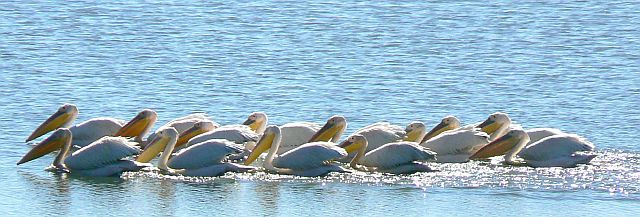 © Toko
© Toko
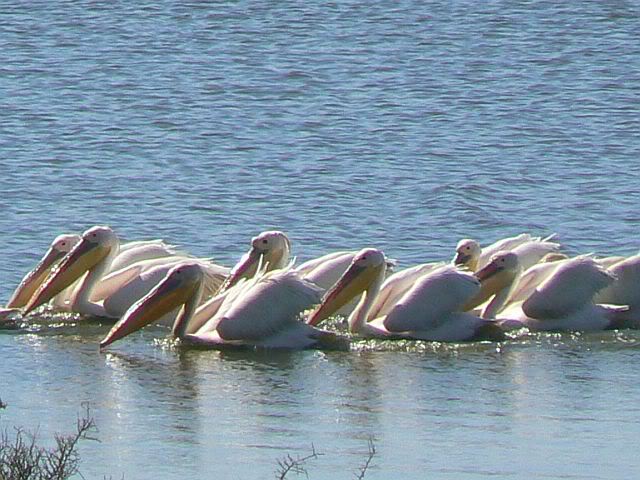 © Toko
© Toko
Vlei near Elandsbaai, Western Cape
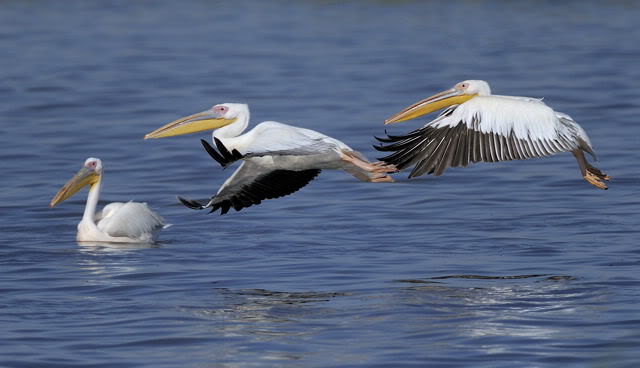 © Dewi
© Dewi
 © Duke
© Duke
Breeding female (left) and male (right)
Links:
Sabap2: http://sabap2.adu.org.za/species_info.p ... #menu_left
ARKive: http://www.arkive.org/great-white-pelic ... ocrotalus/
Thesis: Population dynamics of Great White Pelicans in southern Africa
 © Toko
© Toko © Toko
© TokoVlei near Elandsbaai, Western Cape
 © Dewi
© Dewi © Duke
© DukeBreeding female (left) and male (right)
Links:
Sabap2: http://sabap2.adu.org.za/species_info.p ... #menu_left
ARKive: http://www.arkive.org/great-white-pelic ... ocrotalus/
Thesis: Population dynamics of Great White Pelicans in southern Africa
- Super Mongoose
- Posts: 808
- Joined: Wed Nov 13, 2013 8:10 am
- Country: South Africa
- Location: Pretoria North
- Contact:
Pink-backed Pelican
050. Pink-backed Pelican Pelecanus rufescens (Kleinpelikaan)
Order: Pelecaniformes. Family: Pelecanidae
Description
Length 135-152 cm. Greyish with pink tinge on back, rump, belly and undertail coverts; crest on head fairly distinct; breast feathers long, pointed and somewhat shaggy; remiges darker than rest of plumage, but not black as in White Pelican; tail grey; legs yellow. Iris dark brown; bill greyish, yellowish or pinkish with pink or orange tip and pinkish pouch with yellowish stripes; facial skin greyish pink, black in front of eye; legs and feet orange or yellow.
Adult in non-breeding plumage has grey upperparts and a greyish-white head and underparts, the bill pale yellow with a pink tip, legs buffy-yellow. In flight told from Great White Pelican by greyish underwing and dark grey (not black) flight feathers.
Adult in breeding condition has the bill pouch rich yellow surmounted by a pink edge to the upper mandible, the legs and feet rich orange-yellow; at close range pinkish feathers can be seen on the back.
Juvenile: Brownish; head and neck greyish white; belly, rump and back white. Chick: Naked pink, later covered with white down.
Distribution
Occurs from south-west Arabia to much of sub-Saharan Africa. In southern Africa, it is locally fairly common in central and southern Mozambique, south-western Zimbabwe, northern Botswana, the Caprivi Strip and north-eastern South Africa.

Habitat
It can occupy a variety of wetland types, generally preferring dams, lakes, slow-moving rivers, lagoons, saline pools, estuaries, lagoons and sheltered bays.
Movements and migrations
Resident and locally nomadic, moving in response to changes in wetland conditions, although juveniles tend to wander considerably longer distances than adults.
Diet
It mainly eats fish, such as tilapia (Tilapia and Haplochromis), occasionally supplemented with fruit, doing most of its foraging alone in the period from in the morning and evening. It generally stays close to the shore in shallow water, catching prey underwater with its large bill pouch, draining the water out before throwing its head back and swallowing the prey whole.
Breeding
Monogamous, breeding in colonies of roughly 15-140 pairs, often along with storks, herons, African spoonbills and African darters. Groups of males display and attack each other, each selecting a nest site where he performs to passing females. The nest is built by the female in about a week, with material gathered by the male, consisting of an untidy stick platform with a shallow central depression. It is typically placed in the canopy of a tree (often over water) or occasionally on an island or reedbed. Egg-laying season is from June-January. It lays 1-4 eggs at 2-3 days intervals, which are incubated by both sexes for 30-35 days. Eggs are pale bluish with chalky white covering. The chicks are fed by both parents and brooded for the first few weeks of their lives; younger chicks often die of starvation due to intense competition for food with their older siblings. The oldest chick sometimes pecks the eyes of the other chicks, causing them to fall off the nest. They take their first flight at roughly 12 weeks old, leaving the nest completely a few days later.
Status
Uncommon resident N KwaZulu-Natal northwards; vagrant elsewhere.
Order: Pelecaniformes. Family: Pelecanidae
Description
Length 135-152 cm. Greyish with pink tinge on back, rump, belly and undertail coverts; crest on head fairly distinct; breast feathers long, pointed and somewhat shaggy; remiges darker than rest of plumage, but not black as in White Pelican; tail grey; legs yellow. Iris dark brown; bill greyish, yellowish or pinkish with pink or orange tip and pinkish pouch with yellowish stripes; facial skin greyish pink, black in front of eye; legs and feet orange or yellow.
Adult in non-breeding plumage has grey upperparts and a greyish-white head and underparts, the bill pale yellow with a pink tip, legs buffy-yellow. In flight told from Great White Pelican by greyish underwing and dark grey (not black) flight feathers.
Adult in breeding condition has the bill pouch rich yellow surmounted by a pink edge to the upper mandible, the legs and feet rich orange-yellow; at close range pinkish feathers can be seen on the back.
Juvenile: Brownish; head and neck greyish white; belly, rump and back white. Chick: Naked pink, later covered with white down.
Distribution
Occurs from south-west Arabia to much of sub-Saharan Africa. In southern Africa, it is locally fairly common in central and southern Mozambique, south-western Zimbabwe, northern Botswana, the Caprivi Strip and north-eastern South Africa.

Habitat
It can occupy a variety of wetland types, generally preferring dams, lakes, slow-moving rivers, lagoons, saline pools, estuaries, lagoons and sheltered bays.
Movements and migrations
Resident and locally nomadic, moving in response to changes in wetland conditions, although juveniles tend to wander considerably longer distances than adults.
Diet
It mainly eats fish, such as tilapia (Tilapia and Haplochromis), occasionally supplemented with fruit, doing most of its foraging alone in the period from in the morning and evening. It generally stays close to the shore in shallow water, catching prey underwater with its large bill pouch, draining the water out before throwing its head back and swallowing the prey whole.
Breeding
Monogamous, breeding in colonies of roughly 15-140 pairs, often along with storks, herons, African spoonbills and African darters. Groups of males display and attack each other, each selecting a nest site where he performs to passing females. The nest is built by the female in about a week, with material gathered by the male, consisting of an untidy stick platform with a shallow central depression. It is typically placed in the canopy of a tree (often over water) or occasionally on an island or reedbed. Egg-laying season is from June-January. It lays 1-4 eggs at 2-3 days intervals, which are incubated by both sexes for 30-35 days. Eggs are pale bluish with chalky white covering. The chicks are fed by both parents and brooded for the first few weeks of their lives; younger chicks often die of starvation due to intense competition for food with their older siblings. The oldest chick sometimes pecks the eyes of the other chicks, causing them to fall off the nest. They take their first flight at roughly 12 weeks old, leaving the nest completely a few days later.
Status
Uncommon resident N KwaZulu-Natal northwards; vagrant elsewhere.
- Super Mongoose
- Posts: 808
- Joined: Wed Nov 13, 2013 8:10 am
- Country: South Africa
- Location: Pretoria North
- Contact:
Pink-backed Pelican Photos
050. Pink-backed Pelican Pelecanus rufescens
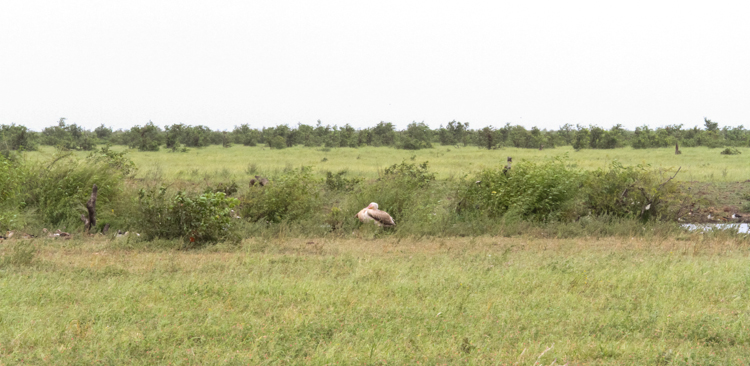 © Super Mongoose
© Super Mongoose
Tihongonyeni Waterhole, Kruger National Park
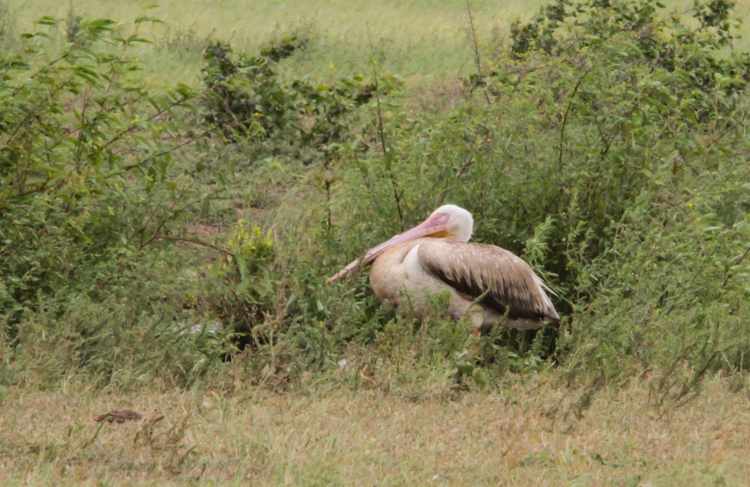 © Super Mongoose
© Super Mongoose
Tihongonyeni Waterhole, Kruger National Park
Links:
Sabap2: http://sabap2.adu.org.za/species_info.p ... #menu_left
Newman's Birds of Southern Africa
NEWMAN'S VOELS VAN SA (8ste UIT)
 © Super Mongoose
© Super MongooseTihongonyeni Waterhole, Kruger National Park
 © Super Mongoose
© Super MongooseTihongonyeni Waterhole, Kruger National Park
Links:
Sabap2: http://sabap2.adu.org.za/species_info.p ... #menu_left
Newman's Birds of Southern Africa
NEWMAN'S VOELS VAN SA (8ste UIT)
Last edited by Super Mongoose on Thu Jul 24, 2014 8:22 am, edited 1 time in total.
ORDER SULIFORMES
The order Suliformes is a proposed order by the International Ornithologist's Union. In 2010, the AOU adopted the term Suliformes for the taxon. The I O C followed in 2011. Four avian families comprise the brand new order Suliformes:
ORDER SULIFORMES
Family Fregatidae (Frigatebirds)
Family Sulidae (Gannets, Boobies)
Family Phalacrocoracidae (Cormorants)
Family Anhingidae (Darters)
They are all primarily fish-eaters adapted for life in the water and the air.
ORDER SULIFORMES
Family Fregatidae (Frigatebirds)
Family Sulidae (Gannets, Boobies)
Family Phalacrocoracidae (Cormorants)
Family Anhingidae (Darters)
They are all primarily fish-eaters adapted for life in the water and the air.
Family Sulidae (Gannets, Boobies)
The bird family Sulidae comprises the gannets and boobies. Collectively called sulids, they are medium-large coastal seabirds that plunge-dive for fish and similar prey. The ten species in this family are often considered congeneric in older sources, placing all in the genus Sula. However, Sula (true boobies) and Morus (gannets) can be readily distinguished by morphological and behavioral and DNA sequence characters.
Sulids measure about 60 to 85 cm in length and have a wingspan of about 140 to 175 cm. They have long, narrow and pointed wings, and a quite long, graduated and rather lozenge-shaped tail whose outer feathers are shorter than the central ones. Their flight muscles are rather small to allow for the small cross section required for plunge-diving, and thus their wing loading is high. Consequently, they are very streamlined, reducing drag, so their bodies are "torpedo-shaped" as well as somewhat flat.
They have stout legs and webbed feet, with the web connecting all four toes. In some species the webs are brightly colored and used in courtship displays. The bill is usually conspicuously colored, long, deep at the base, and pointed, with saw-like edges. The upper mandible curves down slightly at the tip and can be moved upward to accept large prey. To keep water out during plunges, the nostrils enter into the bill rather than opening to the outside directly. The eyes are angled forward, and provide a wider field of binocular vision than in most other birds.
The plumage is either all-white (or light brownish or greyish) with dark wingtips and (usually) tail, or at least some dark brown or black above with white underparts; gannets have a yellowish hue to the head. The face usually has some sort of black markings, typically on the lores. Unlike their relatives (the darters and cormorants), sulids have a well-developed preen gland whose waxy secretions they spread on their feathers for waterproofing and pest control.
All species feed entirely at sea, mostly on mid-sized fish and similarly-sized marine invertebrates (e.g. cephalopods). The typical hunting behavior is a dive from mid-air, taking the bird a meter or two under water. If prey manages to escape the diving birds at first, they may give chase using their legs and wings for underwater swimming.
All sulids breed in colonies. Males examine the colony area in flight and then pick a nest site, which they defend by fighting and by territorial displays. Males then advertise to females by a special display and call. The display behaviour is characteristic, it typically includes the male shaking its head.
The clutch is typically 2 eggs. Incubation lasts 42 to 55 days, depending on the species. Both sexes incubate; like their relatives they do not have brood patches, but their feet become vascularized and hot, and the birds place the eggs under the webs. Eggs lost during the first half of incubation are replaced.
At hatching, parents move the eggs and then the hatchlings to the tops of their webs. The young hatch naked, but soon develop white down. They beg by touching the parent's bill and take regurgitated food straight from its gape. At first at least one parent is always in attendance of the altricial young; after two weeks, both parents leave the nest unguarded at times while they go fishing. Siblicide by the stronger of two chicks is frequent.
Species indigenous to southern Africa:
Family Sulidae (Gannets, Boobies)
Morus capensis Cape Gannet 053
Morus serrator Australian Gannet 054
Sula dactylatra Red-footed Booby
Sula leucogaster Brown Booby 052
Sulids measure about 60 to 85 cm in length and have a wingspan of about 140 to 175 cm. They have long, narrow and pointed wings, and a quite long, graduated and rather lozenge-shaped tail whose outer feathers are shorter than the central ones. Their flight muscles are rather small to allow for the small cross section required for plunge-diving, and thus their wing loading is high. Consequently, they are very streamlined, reducing drag, so their bodies are "torpedo-shaped" as well as somewhat flat.
They have stout legs and webbed feet, with the web connecting all four toes. In some species the webs are brightly colored and used in courtship displays. The bill is usually conspicuously colored, long, deep at the base, and pointed, with saw-like edges. The upper mandible curves down slightly at the tip and can be moved upward to accept large prey. To keep water out during plunges, the nostrils enter into the bill rather than opening to the outside directly. The eyes are angled forward, and provide a wider field of binocular vision than in most other birds.
The plumage is either all-white (or light brownish or greyish) with dark wingtips and (usually) tail, or at least some dark brown or black above with white underparts; gannets have a yellowish hue to the head. The face usually has some sort of black markings, typically on the lores. Unlike their relatives (the darters and cormorants), sulids have a well-developed preen gland whose waxy secretions they spread on their feathers for waterproofing and pest control.
All species feed entirely at sea, mostly on mid-sized fish and similarly-sized marine invertebrates (e.g. cephalopods). The typical hunting behavior is a dive from mid-air, taking the bird a meter or two under water. If prey manages to escape the diving birds at first, they may give chase using their legs and wings for underwater swimming.
All sulids breed in colonies. Males examine the colony area in flight and then pick a nest site, which they defend by fighting and by territorial displays. Males then advertise to females by a special display and call. The display behaviour is characteristic, it typically includes the male shaking its head.
The clutch is typically 2 eggs. Incubation lasts 42 to 55 days, depending on the species. Both sexes incubate; like their relatives they do not have brood patches, but their feet become vascularized and hot, and the birds place the eggs under the webs. Eggs lost during the first half of incubation are replaced.
At hatching, parents move the eggs and then the hatchlings to the tops of their webs. The young hatch naked, but soon develop white down. They beg by touching the parent's bill and take regurgitated food straight from its gape. At first at least one parent is always in attendance of the altricial young; after two weeks, both parents leave the nest unguarded at times while they go fishing. Siblicide by the stronger of two chicks is frequent.
Species indigenous to southern Africa:
Family Sulidae (Gannets, Boobies)
Morus capensis Cape Gannet 053
Morus serrator Australian Gannet 054
Sula dactylatra Red-footed Booby
Sula leucogaster Brown Booby 052
Cape Gannet
053. Cape Gannet Morus capensis (Witmalgas)
Order: Suliformes. Family: Sulidae
Description
87-100 cm. A striking black and white seabird with yellow head and hindneck. There are also distinctive black lines around the beak and on the face.The strong, pale blue bill is pointed with fine serrations near the tip, and the large feet are webbed between each toe. When seen in flight, the black colour of the tail, primaries and secondaries, and stripe down the centre of the throat, provides a striking contrast to the otherwise white body.
Juveniles are dark brown, and gradually gain increasing amounts of the white feathers of the adult plumage after their first year.
Distribution
Can be seen off all the coasts in the subregion. Breeding occurs at six offshore islands: Mercury, Ichaboe and Possession off the Namibian coast, and Bird Island, Lambert's Bay; Malgas Island, Saldanha Bay off the west coast of South Africa, and one (Bird Island, Port Elizabeth) off the east coast of South Africa. For birdwatchers, the colony at Lamberts Bay is the most accessible of the six gannet colonies in South Africa and Namibia. (There are approximately twenty thousand pairs of breeding gannets on Bird Island.) The wintering, non-breeding range is restricted to the coast of Africa, where adults are fairly sedentary.

Habitat: Coastal. Singly or in flocks offshore; large aggregations over fish shoals.
Movements and migrations
Adults usually remain within 540 km of the island of their colony in winter, although they may travel up to 3300 km north. Immature birds move more freely however, following sardine shoals up to KwaZulu-Natal or alternatively heading north to West Africa, travelling up to about 6800 km: they even reach western Australia on occasion.
Diet
It mainly eats fish, doing most of its foraging in large flocks of up to about 1000 birds, searching for shoals of fish from the air. Once it locates prey it dives straight into the water, remaining submerged for 3-7 seconds, in which time it can descend up to 8m underwater using just momentum. They feed on fish (Anchovy, Pelagic goby, Saury, Hakes, Snoek, Horse mackerel, Chub mackerel, Round herring, Sardine) and squids.
Breeding
Monogamous colonial nester, living in large and tightly packed colonies of up to about 68000 individuals. The nest is a mound with a depression in the centre, made of guano and other material, which is applied to the structure by vibrating its mandible along the rim. Egg-laying season can be year-round, peaking from September-April. It lays a single egg, rarely two, which is incubated by both sexes for about 43-44 days. The chick is fed by both sexes by regurgitation and brooded for the first 2-3 days of its life. It leaves the nest at 90-105 days old, remaining on the colony edge for another six days or so before dispersing completely.
Call
Usually silent at sea. Rasping arrah arrah is most common call at colonies. Listen to Bird Call.
Status
Common to locally abundant endemic resident. Classified as Vulnerable (VU) on the IUCN Red List. Its population has decreased by at least 20% in three generations, and is especially in trouble in Namibia. Numbers at the Namibian islands have declined considerably between 1956 and 2000 from 114,600 to 18,200 breeding pairs respectively, an 84% decrease in less than fifty years. This is largely due to the collapse of Sardine (Sardinops sagax) and other fish stock, as well as occasional oil spills which cause hundreds of deaths. This contrasts with the trends at the South African islands where numbers have increased about 4.3 times during the same period, from 34,400 to 148,000 breeding pairs. All breeding colonies of the Cape Gannet are under some form of protection.
Order: Suliformes. Family: Sulidae
Description
87-100 cm. A striking black and white seabird with yellow head and hindneck. There are also distinctive black lines around the beak and on the face.The strong, pale blue bill is pointed with fine serrations near the tip, and the large feet are webbed between each toe. When seen in flight, the black colour of the tail, primaries and secondaries, and stripe down the centre of the throat, provides a striking contrast to the otherwise white body.
Juveniles are dark brown, and gradually gain increasing amounts of the white feathers of the adult plumage after their first year.
Distribution
Can be seen off all the coasts in the subregion. Breeding occurs at six offshore islands: Mercury, Ichaboe and Possession off the Namibian coast, and Bird Island, Lambert's Bay; Malgas Island, Saldanha Bay off the west coast of South Africa, and one (Bird Island, Port Elizabeth) off the east coast of South Africa. For birdwatchers, the colony at Lamberts Bay is the most accessible of the six gannet colonies in South Africa and Namibia. (There are approximately twenty thousand pairs of breeding gannets on Bird Island.) The wintering, non-breeding range is restricted to the coast of Africa, where adults are fairly sedentary.

Habitat: Coastal. Singly or in flocks offshore; large aggregations over fish shoals.
Movements and migrations
Adults usually remain within 540 km of the island of their colony in winter, although they may travel up to 3300 km north. Immature birds move more freely however, following sardine shoals up to KwaZulu-Natal or alternatively heading north to West Africa, travelling up to about 6800 km: they even reach western Australia on occasion.
Diet
It mainly eats fish, doing most of its foraging in large flocks of up to about 1000 birds, searching for shoals of fish from the air. Once it locates prey it dives straight into the water, remaining submerged for 3-7 seconds, in which time it can descend up to 8m underwater using just momentum. They feed on fish (Anchovy, Pelagic goby, Saury, Hakes, Snoek, Horse mackerel, Chub mackerel, Round herring, Sardine) and squids.
Breeding
Monogamous colonial nester, living in large and tightly packed colonies of up to about 68000 individuals. The nest is a mound with a depression in the centre, made of guano and other material, which is applied to the structure by vibrating its mandible along the rim. Egg-laying season can be year-round, peaking from September-April. It lays a single egg, rarely two, which is incubated by both sexes for about 43-44 days. The chick is fed by both sexes by regurgitation and brooded for the first 2-3 days of its life. It leaves the nest at 90-105 days old, remaining on the colony edge for another six days or so before dispersing completely.
Call
Usually silent at sea. Rasping arrah arrah is most common call at colonies. Listen to Bird Call.
Status
Common to locally abundant endemic resident. Classified as Vulnerable (VU) on the IUCN Red List. Its population has decreased by at least 20% in three generations, and is especially in trouble in Namibia. Numbers at the Namibian islands have declined considerably between 1956 and 2000 from 114,600 to 18,200 breeding pairs respectively, an 84% decrease in less than fifty years. This is largely due to the collapse of Sardine (Sardinops sagax) and other fish stock, as well as occasional oil spills which cause hundreds of deaths. This contrasts with the trends at the South African islands where numbers have increased about 4.3 times during the same period, from 34,400 to 148,000 breeding pairs. All breeding colonies of the Cape Gannet are under some form of protection.
Cape Gannet Photos
053. Cape Gannet Morus capensis (Witmalgas)
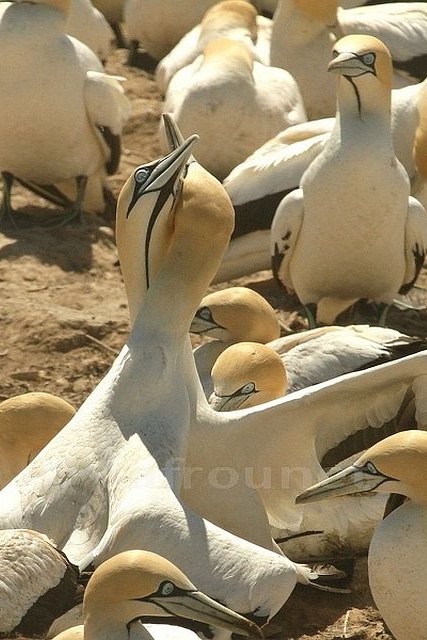 © nan
© nan
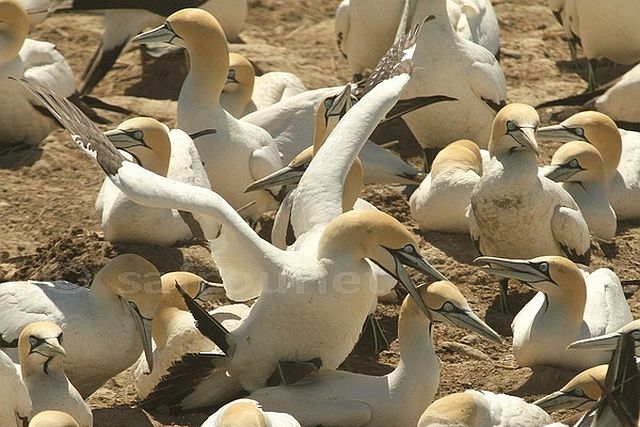 © nan
© nan
Lamberts Bay
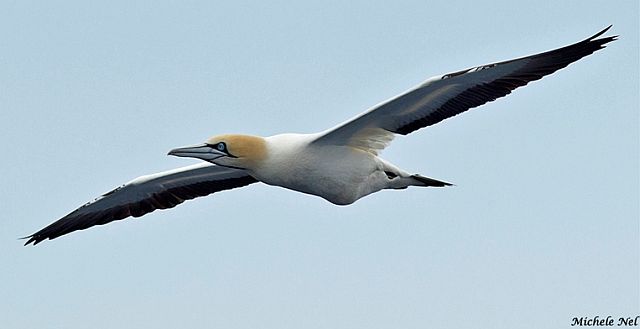 © Michele Nel
© Michele Nel
 © Michele Nel
© Michele Nel
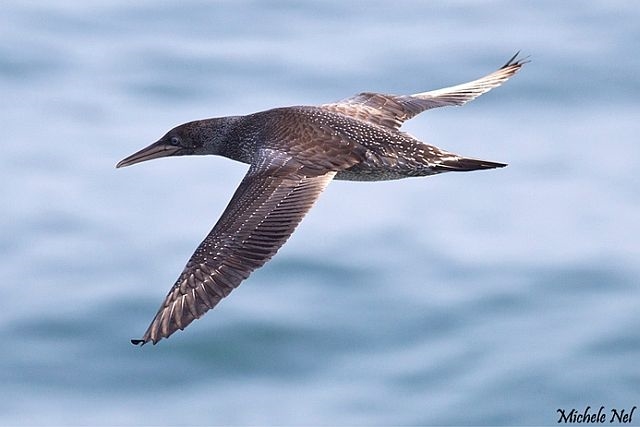 © Michele Nel
© Michele Nel
Juvenile
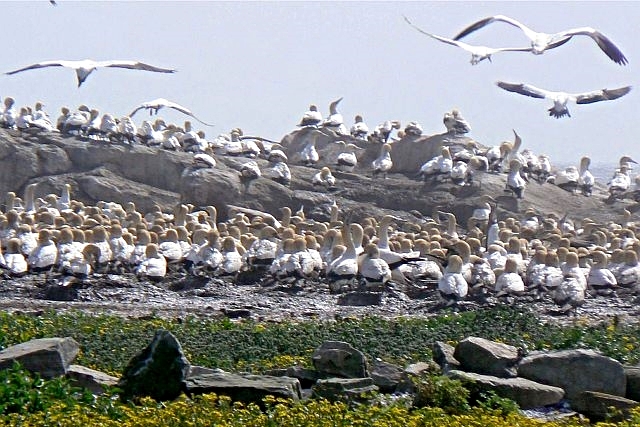 © Toko
© Toko
 © Toko
© Toko
Breeding Colony at Bird Island, Lamberts Bay
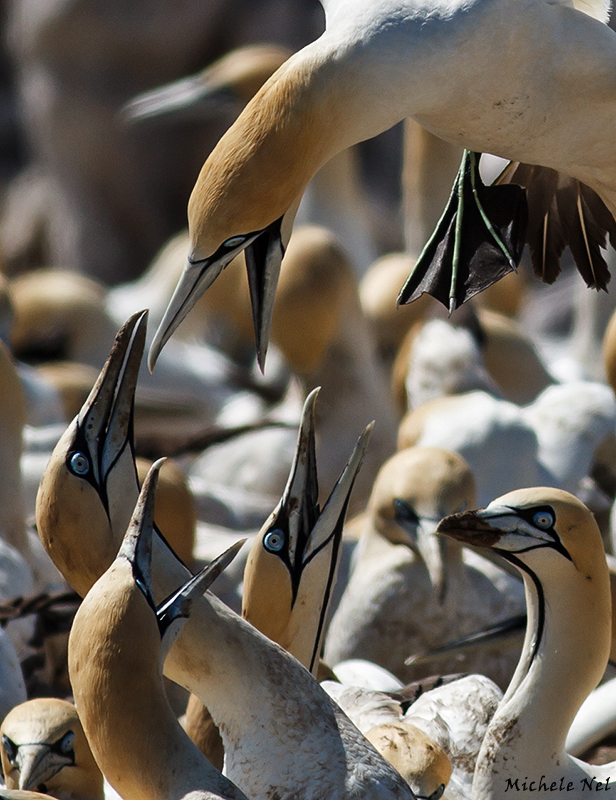 © Michele Nel
© Michele Nel
Bird Island, Lambert's Bay
Links:
Species text in The Atlas of Southern African Birds: http://sabap2.adu.org.za/docs/sabap1/053.pdf
Sabap2: http://sabap2.adu.org.za/species_info.p ... #menu_left
Avian Demography Unit
Animal Diversity Web
Oiseaux net: http://www.oiseaux-birds.com/card-cape-gannet.html
Cape Gannet movements in Africa
ARKive: http://www.arkive.org/cape-gannet/morus-capensis/
 © nan
© nan © nan
© nanLamberts Bay
 © Michele Nel
© Michele Nel © Michele Nel
© Michele Nel © Michele Nel
© Michele Nel Juvenile
 © Toko
© Toko © Toko
© TokoBreeding Colony at Bird Island, Lamberts Bay
 © Michele Nel
© Michele NelBird Island, Lambert's Bay
Links:
Species text in The Atlas of Southern African Birds: http://sabap2.adu.org.za/docs/sabap1/053.pdf
Sabap2: http://sabap2.adu.org.za/species_info.p ... #menu_left
Avian Demography Unit
Animal Diversity Web
Oiseaux net: http://www.oiseaux-birds.com/card-cape-gannet.html
Cape Gannet movements in Africa
ARKive: http://www.arkive.org/cape-gannet/morus-capensis/


